



[TOKYO, Japan, 10 May 2011]
The Japan Committee for UNICEF (JCU) has carried out assistance activities for children since immediately following the Great East Japan Earthquake. Partner corporations and organizations with which JCU has developed collaborative relationships over many years have played vital roles in implementing these activities.
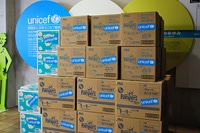 |
| © Japan Committee for UNICEF |
On 13 March, just two days following the earthquake, JCU for the first time in history made the decision to launch assistance activities domestically within Japan. Thereafter, JCU commenced preparations so that emergency relief supplies would reach disaster victims at the earliest stage possible.
At first, all types of supplies were needed in the disaster area; however, it was extremely difficult to procure and transport those supplies to the affected areas. JCU first coordinated with the disaster management headquarters of Miyagi, Iwate and Fukushima Prefectures in distributing drinking water donated from corporations to the disaster victims in those areas. Similarly, JCU was able to secure children’s diapers and wipes donated by P&G Corporation, a global partner corporation of UNICEF, and over 200,000 pairs of children’s underwear from AEON, who has assisted JCU for many years in implanting assistance activities for children in developing countries. Thanks to the cooperation of these partners JCU was able to promptly deliver the supplies to children in the disaster area.
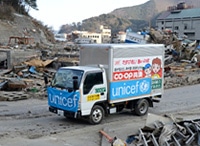 |
| © Japan Committee for UNICEF/2011/K.shindo |
Logistics infrastructure had been severely damaged by the disaster and procuring gasoline was also a significant challenge. Faced with the challenges of securing trucks to transport supplies to the disaster areas, warehouses to serve as logistics centers in the outskirts of the disaster areas as well as trucks to drive from those warehouses to the disaster area, JCU utilized the deep-rooted networks of co-ops in Miyagi and Iwate Prefectures, which have supported the public relations and fundraising aspects of UNICEF activities for more than 30 years. These co-ops assisted in transporting JCU’s emergency relief supplies to shelters in the disaster area, making it possible to ensure that supplies reached disaster victims as quickly as possible.
 |
| © Japan Committee for UNICEF |
Moreover, Nissan Motor donated five four-wheel drive vehicles to JCU to assist with emergency assistance activities. These vehicles are being utilized to transport supplies and people to the disaster areas.
Picture on right: A four-wheel drive vehicle donated by Nissan Motor.
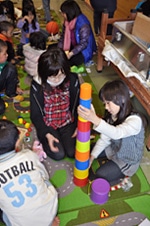 |
| © UNICEF/2011/N.Imoto | Children playing on play mats donated by IKEA. |
In response to growing concerns over the psychological impacts that the horrific disaster will bear on children, JCU has focused efforts on providing psychological care to children since the disaster.
Child Friendly Spaces were set up and operated at shelters and other locations for the purpose of easing the stress of children as much as possible and preventing that stress from developing into psychological problems. A grant was provided by Japan Airlines that allowed the swift transporting of the tools needed to conduct activities at the Child Friendly Spaces—Early Child Development Kits and recreations kits—from the UNICEF Supply Division in Copenhagen to Japan.
Furthermore, IKEA, a global partner of UNICEF, donated play mats, toys, drawing sets and other goods to be used at Child Friendly Spaces. The play mats, in particular, were very popular among the children as they created more comfortable places for children to play, rather than the cold floors of gymnasiums and other buildings. These mats have become a commonly recognized marker of Child Friendly Space locations.
Life at the shelters continues to drag on and one of the concerns of staff engaged in assistance on-site is the nutritional situation of disaster victims. In response, various corporations have extended assistance, such as by providing supplements, to disaster victims. One of those corporations, Mannatech Japan, donated a caramel-like supplement that contains micronutrients. These efforts contribute to improving the nutritional condition of children.
Moreover, JCU plans to provide mopeds and cars so that municipal healthcare centers in disaster areas can restart traveling clinic and home-visit nursing activities. The production of cars and other vehicles has been severely affected as a result of the disaster, but we were nevertheless able to secure 18 mopeds and 39 cars through the cooperation of Honda DREAM Tokyo and Honda Cars Chuo Tokyo, providing those vehicles to local municipal governments.
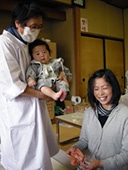 |
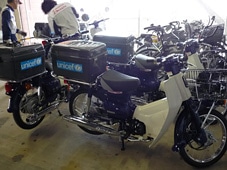 |
|
| © Japan Committee for UNICEF | © Honda DREAM Tokyo Co., Ltd. | |
| Mopeds delivered to Onagawa Town, Ishinomaki City and Minamisanriku Town in Miyagi Prefecture. |
JCU has implemented the Back to School campaign so that children in the disaster area are able to return to school by the new school year. We have extended assistance to over 200,000 children in Miyagi and Iwate Prefectures so far. In Iwate Prefecture, with the cooperation of Kyokuto Associates we were able to create packaged sets of the necessary notebooks and school supplies for each grade, from primary to junior high school. We have delivered these sets to more than 17,000 children that attend schools in the disaster area thanks to the cooperation of the Iwate Prefecture School Co-op and Teacher’s Union. Moreover, similarly packaged sets were prepared by school co-ops in Miyagi Prefecture. JCU even acquired the assistance of ferry operators to help deliver these school supplies to children that live on islands that trucks cannot reach.
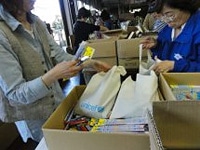 |
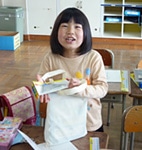 |
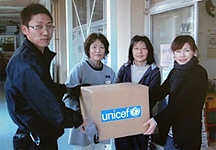 |
||
| © Japan Committee for UNICEF | © Japan Committee for UNICEF | © Japan Committee for UNICEF | ||
| Volunteers traveled from Hiroshima, Okayama, Kagawa and Ehime Prefectures to assist with the packaging of school supplies. | A girl receiving supplies delivered to Takada Primary School in Iwate Prefecture. | A UNICEF Children’s Mini Library delivered to Oshima Children’s House in Kesennuma. Staff helped haul the books to the Children’s House from the ferry on their shoulders. |
JCU will continue to implement assistance activities with the cooperation of its many partner corporations and organizations.
| Receiving Prefecture |
Type of Emergency Supplies |
Arrival Date |
Quantity | Donating Company |
Comments |
|---|---|---|---|---|---|
| Miyagi | Water | 19 Mar. | 12,288 bottles |
VanaH Co., Ltd. | Two-liter plastic bottles |
| Fukushima | Water | 22 Mar. | 12,672 bottles |
VanaH Co., Ltd. | Two-liter plastic bottles |
| Miyagi | Underwear for boys and girls | 22 Mar. | 200,000 | ||
| Iwate | Underwear for boys and girls | 23 Mar. | 30,000 | ||
| Fukushima | Water | 23 Mar. | 4,680 bottles |
KIRIN MC DANONE WATERS Co., Ltd. | Two-liter plastic bottles |
| Miyagi | Children’s shoes | 23 Mar. | 10,000 pairs |
||
| Miyagi | Children’s diapers | 24 Mar. | 80 packs | P&G Japan | |
| Iwate | Children’s underwear | 24 Mar. | 9,700 | ||
| Fukushima | Water | 24 Mar. | 12,288 bottles |
VanaH Co., Ltd. | Two-liter plastic bottles |
| Iwate | Shoes | 26 Mar | 1,404 pairs | Achilles Corporation | |
| Iwate | Underwear for boys and girls | 27 Mar. | 28,266 | ||
| Iwate | Boots | 27 Mar. | 7,462 pairs | ||
| Iwate | Wipes | 28 Mar. | 1,200 | P&G Japan | For babies |
| Miyagi | Recreation kits Early Childhood Development kits |
2 Apr. | 50 of each | Procured from the UNICEF Supply Division | |
| Iwate | Recreation kits Early Childhood Development kits |
2 Apr. | 50 of each | Procured from the UNICEF Supply Division | |
| Miyagi | Book bags | 6 Apr. | 70 | Nihon New Bag Chain | |
| Iwate | Book bags | 6-7 Apr. | 340 | Seiban | |
| Miyagi | Schoolbags | 8 Apr. | 18,000 | Procured from the UNICEF Supply Division | |
| Iwate | Schoolbags | 8 Apr. | 18,000 | Procured from the UNICEF Supply Division | |
| Miyagi | Personal security buzzers (for crime prevention purposes) | 8 Apr. | 5,000 | ||
| Iwate | Personal security buzzers (for crime prevention purposes) | 8 Apr. | 5,000 | ||
| Miyagi | Minicar | 8 Apr. | 3 cars | ||
| Fukushima | Water | 11 Apr. | 1,536 bottles | VanaH Co., Ltd. | Two-liter plastic bottles |
| Miyagi | Replenishments for recreation kits | 12 Apr. | 60 sets | ||
| Miyagi | Miniature toy cars | 12 Apr. | Approx. 1,200 | TAKARA TOMY | |
| Sagamihara* | Water | 12 Apr. | 12,288 bottles | VanaH Co., Ltd. | Two-liter plastic bottles |
| Miyagi | Play mats | 13 Apr. | Two types; 80 of each type | IKEA | |
| Miyagi | Drawing sets | 13 Apr. | 60 sets | IKEA | |
| Iwate | Preschool-size chairs, tables and low tables | 14 Apr. | 75 chairs; 11 tables; 9 low tables | Donated to preschools, primary schools, junior high schools and high schools in the disaster area as well as their new locations | |
| Miyagi | Mopeds | 15 Apr. | 5 | ||
| Iwate | Notebooks and stationery sets for primary and junior high school students | 15. Apr. | 16,700 sets | ||
| Miyagi | 183 computers; 57 copiers and fax machines; 61 printers | 18-21 Apr. | Distributed to preschools, primary schools, junior high schools and high schools in the disaster area as well as their new locations | ||
| Fukushima | Movable blackboards | 21 Apr. | 10 | ||
| Fukushima | Temporary toilets | 21 Apr. | 20 |
Number of UNICEF Children’s Mini Libraries distributed: Approximately 250 (as of 28 April 2011)
*Areas receiving disaster victims.
*In certain cases some supplies may be taken from prefectural supply storage warehouses and distributed to shelters and disaster sites in other prefectures.
As of 9:00 a.m. on 28 April 2011 (compiled by the Information and Public Affairs Division).